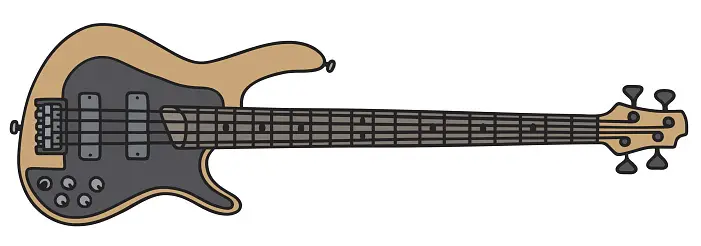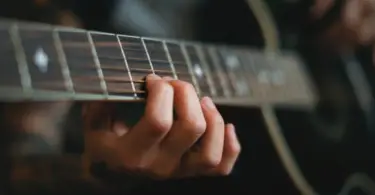Welcome to my left bass buying guide. Before I get to my top pick, I have a lot to say about shopping for a left-handed bass. I want to explain what’s important in a lefty bass, and then go through options up and down the price spectrum, so you have plenty of choices.

Credit: Musician’s Friend
Top Pick: Ibanez SR300L
A well-rounded choice with value and versatility. Beautifully and comfortably designed, with flexible tone.
Why You Should Trust Us
I am an experienced guitar and bass player, and I have also written many buying guides. For this one, I scoured the Internet for the best left-handed guitars and read their reviews and descriptions. I also enlisted the help of a left-handed player friend for testing, because I myself am a righty.
By the end, I had amassed plenty of data about not just what good lefty basses are available but what sets them apart from the competition.
What to Look For in a Lefty Bass
There is an extent to which searching for a good lefty bass is just like any other musical instrument. Your first concern is the sound it can produce. The selection might not be as wide because not every manufacturer produces all of their units in lefty form, but this is becoming more and more common.
Design and Features
Nobody would argue that how a bass looks is not at least a little important. You want it to be cool, of course, and what exactly that means is up to you. However, if you are playing metal, then I am guessing you are not looking for a soft cherry finish. Don’t be afraid to let appearance matter: you want to be able to take pride in your instrument.
There are other choices in appearance and style. For example, there is a lot of variation in scale length. That can have a significant impact on both how the bass looks and how it plays.
The number of strings also matters. Having a different number of strings can totally change the experience of playing a bass. The complication for lefties is that anything outside the standard four strings is a specialty instrument and less likely to have a lefty version.
That isn’t always true, but in general, the more complex or unusual the design of the bass is, the less likely it is to come in a lefty version. That is because these are more expensive to make, so the risks of them going unsold are greater.
You also might have preferences about key attributes like the onboard preamp, the pickups, the action of the strings, and other things that can vary from model to model.
Often if you cannot find exactly what you want you will be able to find a similar version from the same company. This can help you once you have settled on a particular style and are just looking for some specifics to help you make a final call.
Price
You cannot neglect the importance of the price tag. A good bass needs to have a good price. This is especially true if you are planning to travel with it because that exposes it to greater risk of damage. Regardless of the price, you should get a hard shell case to protect it in storage.
Remember to leave room for the amp. If you already have an amp, so much the better, but if not then you can probably expect to pay half as much on the amp as you did on the bass, if not more.
You want your bass to last for a long time, but that does not mean you should overspend on gear. It is a delicate balance because lefties often wind up needing to pay more for their basses. That can leave fewer funds for other things.
The best way to ensure you get a good deal is to do a lot of research, like I did. Try to test out as many candidates as you can in person. There is only so much you can learn from reading descriptions. Even if you cannot get your hands on exactly the same model, you may be able to get close. That lets you get a feel for whether a bass is worth the price.
Old vs. New
There is a big decision you will have to make when it comes to which basses you are looking at, and that is whether you want a modern model or a reissue of a classic. This comes down to whom you are trying to emulate or where your style is taking you. Sometimes I want to capture a certain sound from history, and other times I want to build my own thing.
Guitar companies are getting better about building left-handed reissues of their old models, which is good because the originals often had very limited production for lefties. The reissues do an excellent job at capturing the original tone.
Spend some time reading about your favorite musicians and what they play. They will often have several bass guitars and rotate between them for different uses.
How to Turn a Right-Handed Guitar into a Lefty
You should be able to find a good left-handed bass from nearly any maker. If all else fails, then you can consider taking a right-handed one and flipping it. This should be a last resort if you really want one particular tone and you cannot recreate it with any lefty options.
To flip a righty guitar so it will work for you, you will need to turn it upside down and also restring it so the strings are in opposite order. That will ensure that the tuning still makes sense. This is not an ideal solution because it can be uncomfortable and awkward depending on the shape of the body and the neck, but it might be your only option. It can also broaden your range of choices if you are having trouble finding one you like.
The tone of the bass will also depend on your other gear, of course. But with experience you will know exactly what you want, so that will inform your decision. Especially if you are not planning to play live, the sound should always be the first consideration for bass players, no matter which hand you use where.
The Competition
After hours of testing and research, here's the final competition.
| Instrument | Rating | Current Pricing |
|---|---|---|
Ibanez SR300L | great tone for jazz, blues, and other genres |  |
Schecter Stiletto Studio-5 | makes a statement through its great tone, and its look and feel |  |
Fender Standard Left-Handed Jazz Bass | One of the most iconic bass guitars in history | |
Fender American Standard | beautiful look, and tone as well |  |
Ibanez Mikro | short scale makes easier to play as well as to transport |  |
Squier Modified Jazz Bass | sound captures that old-school Squier feel |  |
Our Recommendation: The Ibanez SR300L

Credit: Musician’s Friend
If you want a solid, all-around bass, then check out the Ibanez SR300L. Coming from Ibanez, it does have a slight bias towards the rock and metal side of things, but it is quite flexible. You will be able to get a great tone out of it for jazz, blues, or other genres.
A big part of that flexibility is the onboard active equalizer. It is a preamp that can shape your tone before it hits any of the rest of your signal chain. That sets up exactly the sound you want using nothing more than a few knobs.
Not only can you carefully select a tone that you love, but you can also adjust it quickly and easily on the fly. That is not the case if you are relying completely on pedals and an amp to control your sound. Those are much harder to change in mid-gig. Both pickups are EXF.
The design is beautiful, yet simple. The body is agathis with a sleek black finish. The neck is maple and rosewood and is constructed of five separate pieces of wood, although that does not hurt the resonance. It is a joy to play. The neck, in particular, is fast and easy, and the knobs are positioned well for a left-handed player to use.
At around $400, it is more expensive than some entry-level bass guitars, but the boost in quality is very noticeable. The tone sounds very good all through the spectrum, and you can do a lot with the Style Sweeper EQ. It does require batteries for that EQ, specifically a 9-volt.
It is comfortable and well-balanced. That makes playing extended sessions easy. Do not assume that just because of the brand and the paint job it cannot play funk or whatever you prefer. Give it a try, and you might be surprised by how the EQ lets you produce a huge variety of tone profiles.
Runner Up: Schecter Stiletto Studio-5

Credit: Musician’s Friend
My second place pick is the Schecter Stiletto Studio-5. As you may have guessed by now my personal inclinations are on the harder side, so this is a bit of a personal pick, but I think it is worth the attention.
The Stiletto Studio-5 is higher on the price spectrum at nearly $900, but for that price you get beautiful and durable construction, top-end EMG-40Hz pickups, Grover tuners, a flexible and powerful equalizer, and a slightly enlarged 35-inch scale. It is an instrument that makes a statement through its great tone as well as how it looks and feels.
As the name suggests, it has a fifth string for a little extra low end if you want it. There is a version with only four strings if you do not want the fifth, and you can save a little money that way. This is an option that might be out of your budget range, but it is a good marker for what you can get at the upper side of the mass market, and it is still good value for that tier of pricing.
Other Lefty Bass Guitars:
In this section, I will briefly run down some other options for you to consider. I do not personally put them on the same level as my #1 and #2, but I do think all of them are good value for money and all have something going for them. Use this list as inspiration to look more closely at a few instruments.
Fender Standard Left-Handed Jazz Bass

Credit: Musician’s Friend
Fender American Standard

Credit: Musician’s Friend
Ibanez Mikro

Credit: Musician’s Friend
Squier Modified Jazz Bass

Credit: Musician’s Friend








Start the discussion at talk.hearthemusicplay.com